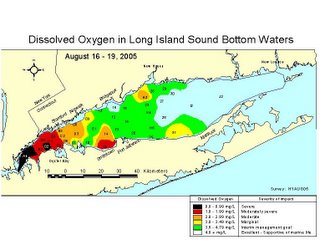AvalonBay and Long Island Sound
There’s more to it than that of course. If you’re going to build apartments in metropolitan New York, you’d better be making some of them affordable. Avalon does that in Connecticut where, as someone noted yesterday in a comment to this post, the company deftly uses state affordable housing laws to force communities to accept multifamily housing. It did this in New Canaan, for example, on the site of an old hardware store very near the train station. Although some people (my wife, for example) may quibble with the aesthetics, it’s not a terrible project, it’s not out of character with downtown New Canaan (which has a lot of attached housing), and it meets at least some of the characteristics of so-called smart growth.
Bryan Brown, in another comment to yesterday’s post, noted that Glen Cove happily embraced an Avalon project and that the proposal had no local opposition. (In a version of the friend of my enemy is my enemy, Bryan also points out that an Avalon VP “took time out of his busy schedule” to write a letter to FERC in support of Broadwater’s LNG proposal. “If you were on the fence about Avalon before, perhaps their lobbying for Broadwater will push you over,” Bryan says, although whether he means me or others isn’t clear.)
But Avalon’s success and reception in other towns is not reason to look at other proposals uncritically. Kyle Rabin, of Friends of the Bay, makes a number of good points in his comments to the Oyster Bay Town Board, which held a public meeting last night to figure out what to study in the environmental review of a 300-plus unit complex that Avalon Bay wants to build there.
Any new development in the Sound’s watershed will result in more sewage, and more nitrogen in the sewage. Nitrogen of course is the nutrient that triggers the Sound’s biggest ecological problem – hypoxia, or the drop in dissolved oxygen concentrations in summer. As you can see from this image, hypoxia is a severe problem off Oyster Bay.

The local sewer district tried to address the problem by adopting a policy that essentially said that the remaining capacity in the sewage plant would be shared by all property owners in the district, and that no individual owner would be able to use more than his or her share. Rabin writes:
The Sewer District Board decided that it was imperative to have a policy that protected the rights of all property owners within the district regardless of when someone would develop their property. Otherwise, approved rezoning applications that result in a more intense use of the property than currently allowed (based on wastewater generation) would use up available treatment plant capacity. Consequently, other property owners at some future point could find themselves in a position where they could not develop their property as allowed by current zoning because of the lack of available treatment plant capacity. All future applications that come before the District would be reviewed in accordance with the District’s new policy.
AvalonBay would use 5 to 10 percent of the remaining capacity, Rabin says, which is more than its fair share.
Another example is housing density. In developed areas, density is good, generally. The environmental costs and impacts are smaller if you put a lot of people on a small amount of land rather than spreading them out across many acres. But how much is too much?
There is no question that high-density housing has an important role to play in this area and Long Island in general, but AvalonBay’s 300-unit proposal is overkill. It’s equivalent to Wal-Mart proposing one of their superstores in this community. AvalonBay’s current approach represents the ‘big box’ mentality that is afflicting many parts of Long Island.
AvalonBay, a publicly traded company with shareholders to please, is using a cookie cutter approach when in fact they should be thinking ‘outside of the box’ and proposing a development that fits in better with the small town character of this community.
There’s a lot more to this, of course, and there are a lot more opinions and points of view than just Friends of the Bay’s. The group’s website though is a good place to start.



0 Comments:
Post a Comment
<< Home